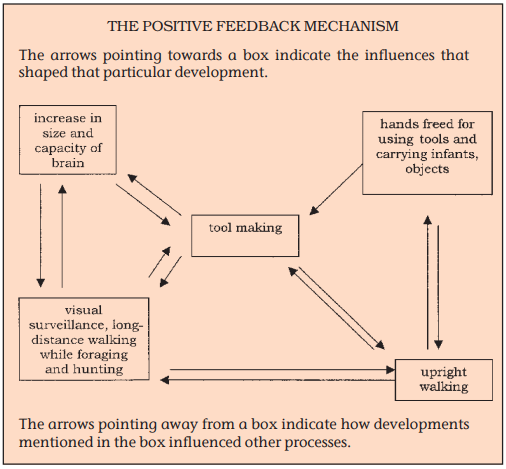From the Beginning of Time - Revision Notes
CBSE Class 11 History
Revision Notes
Chapter 1 : From The Beginning of Time
Story of Human Evolution
Points to remember:
1. Phases of Evolution
Stage 1 - Early Societies
- a. Ape
- b. Australopithecus
- c. Homo erectus (literally ‘upright man’)
- d. Homo sapiens (literally ‘thinking/wise man’)
Stage 2 Hunter-gatherer Societies
- Modern Humans
- Hunters and Gatherers
2. Places of Evolution
The earliest fossils of modern humans where found in:
ETHIOPIA - 195,000-160,000 years ago,
SOUTH AFRICA - 120,000-50,000 years ago,
MOROCCO - 70,000-50,000 years ago,
ISRAEL - 100,000-80,000 years ago,
AUSTRALIA - 45,000-35,000 years ago,
BORNEO - 40,000 years ago,
FRANCE - 35,000 years ago.
3. Social Aspects
- Food
- Shelter
4. Economic Aspects
- Farming
- Domestication of animals
- Trade
5. Cultural Aspects
- Paintings
- Stone Tools
6. Sources
- Fossils
- Stone Tools
- Bones
7. Phases of Stone Age
8. Present day Hunter-Gatherers
i. Role of both-men and Women in present society
SNIPPETS FROM THE CHAPTER
Phases of Evolution
The origin of human begins are divided into several stages:
Primates - A category of larger group of mammals, emerged in Asia and Africa.
- They existed about 36-24 million years ago.
- They existed in Asia and Africa.
Hominoids - A subgroup subgroup amongst primates emerged by about 24 mya, called hominoids.
- This group included Apes who had smaller brains.
- They had four legs but were unable to walk erect.
Hominids - The evidence of the first hominids is found about 5.6 mya in Africa.
- They had an upright posture and bipedal locomotion.
- Hominids belong to a family known as Hominidae, which includes all forms of human beings
- They are further subdivided into branches known as Genus, of which Australopithecus and Homo are important. Each of these in turn includes several species.
Homo is a Latin word, meaning ‘man’ (including women). So human fossils are classified as Homo habilis (the tool maker), Homo erectus (the upright man), and Homo sapiens (the wise or thinking man).
Homo Sapiens (Modern Human) can be further divided into - Homo Heidelbergensis (fossils found in Europe, Asia and Africa) and Homo Neanderthalemsis (fossils found in Europe, Western and Middle Asia)
The remains of early humans have been classified into different species. These are often distinguished from one another on the basis of differences in bone structure. For instance, species of early humans are differentiated in terms of their skull size and distinctive jaws. These characteristics may have evolved due to what has been called the positive feedback mechanism.
Tool – Making – Example – Pg. - 13

Comparison: Modern Human & Hunter Human
Modern Human: On one side some scholars feel that ethnographic data cannot be used for understanding past societies. They have not applied directly the specific data from present day hunter-gather societies to interpret the archeological remains of the post.
They have the ideas:
- Present day hunter-gatherer societies pursues several other economic activities along with hunting and gathering.
- These include engaging in exchange and trade in minor forest produce or working as paid labourers in the fields of neighbouring farmers .
- Moreover, these societies are totally marginalised in all senses - geographically, politically and socially.
- The conditions in which they live are very different from those of early humans.
- There are tremendous variation amongst living hunter - gatherer societies.
- There are conflicting data on many issues such as the relative importance of hunting and gathering, group sizes or the movement from place to place.
- Today generally women gather and men hunt, there are societies where both women and men hunt and gather and make tools. Both women and men are contributing to the food supply.
The Hunter Human
Whereas, there are scholars who have directly applied specific data from present-day hunter-gatherer societies to interpret the archaeological remains of the past. They suggest that hominids sites dated back to 2 mya.
Social Factors
- Food – Example - Hunting began in about 500,000 yrs. ago 'The Hadza' (pg. Text rep. 24)
- Shelter - Date between 700,000 Tools accumulated in one place Example (Map -2 Text reference Europe Pg. 18) Tree shape figure Pg. -19
Economic Factors
- Hunting (began about 500,000 years ago), Gathering, Foraging (to search for food)
- Domestication of animals (began between 10,000 and 4,500 years ago)
- Agriculture and Pastoralism (began around 10,000 years ago)
Cultural Factors
It developed between - 30, 000 and 12,000 years ago
PHASES OF STONE AGE
i. Paleolithic
ii. Mesolithic
iii. Neolithic
a. Neolithic Revolution
Sources
Present day - Hunters and Gatherers
Two - points of view
- Directly applied Specific data from Present day hunter - gatherer Societies to interpret the archeological remains of the past.
- Past societies are totally different from the present society.
Key Words: Fossils, Species, Primates, Hominoids Artefacts, Anthropology, Ethnograph
